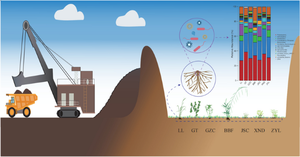Plant and Soil ( IF 3.9 ) Pub Date : 2024-08-17 , DOI: 10.1007/s11104-024-06870-w Dong Zhao , Hua Deng , Lening Hu , Shunyun Ye , Yu Yang , Jiahui Fu , Shuyun Zhang

|
Aims
Ecological restoration of mine tailing ponds plays a crucial role in managing heavy metal pollution and enhancing biodiversity. This study aimed to investigate the ecological restoration potential of pioneer plants under high manganese metal pollution, as well as the microbial community composition and functional characteristics of their rhizosphere soil.
Methods
Sampling and analysis were conducted on seven plants of Neyraudia reynaudiana (LL), Pueraria montana (GT), Bidens pilosa (GZC), Buddleja asiatica (BBF), Pogonatherum crinitum (JSC), Crotalaria albida (XND), Thysanolaena maxima (ZYL) and their rhizosphere soil in Daxin manganese tailing ponds of Guangxi Province.
Results
Pioneer plants improved the physicochemical properties of rhizosphere soil, and increase soil enzyme activity and the abundance and diversity of microbial communities, and reduce soil available metal content. The BTF values of GZC, GT, BBF, and XND are close to or greater than 1 for Mn, Cd and Cu, indicating their strong ability to absorb and transfer heavy metals from underground to above-ground. Proteobacteria, Actinobacteria, and Bacteroidetes are the bacterial communities with the dominant abundance, showing a significant positive correlation with the BTF value and promoting the absorption of heavy metals by plants. FAPROTAX function prediction revealed that chemoheterotrophy, aerobic chemoheterotrophy, and chloroplasts were the main metabolic modes.
Conclusions
GZC, GT, BBF, and XND can be utilized as habitat improvement plants in the preliminary ecological restoration of manganese tailing ponds. Rhizosphere soil microorganisms of pioneer plants respond to heavy metal pollution by regulating community structure and influencing metabolic function.
Graphical abstract
中文翻译:

广西典型锰尾矿库先锋植物土壤系统重金属含量及微生物特征分析
目标
尾矿库的生态修复对于治理重金属污染、增强生物多样性起着至关重要的作用。本研究旨在探讨高锰金属污染下先锋植物的生态恢复潜力及其根际土壤微生物群落组成和功能特征。
方法
对 Neyraudia reynaudiana (LL)、Pueraria montana (GT)、鬼针草 (GZC)、Buddleja asiatica (BBF)、Pogonatherum crinitum (JSC)、Crotalaria albida (XND)、Thysanolaena maxima (ZYL) 七种植物进行了采样和分析。广西大新锰尾矿库及其根际土壤.
结果
先锋植物改善了根际土壤的理化性质,增加了土壤酶活性和微生物群落的丰度和多样性,降低了土壤有效金属含量。 Mn、Cd、Cu的GZC、GT、BBF和XND的BTF值接近或大于1,表明它们具有较强的吸收重金属并将重金属从地下转移到地上的能力。变形菌门、放线菌门和拟杆菌门是占优势丰度的细菌群落,与BTF值呈显着正相关,促进植物对重金属的吸收。 FAPROTAX功能预测显示化能异养、需氧化能异养和叶绿体是主要的代谢模式。
结论
GZC、GT、BBF、XND可作为锰尾矿库初步生态恢复中的生境改善植物。先锋植物根际土壤微生物通过调节群落结构和影响代谢功能来应对重金属污染。
















































 京公网安备 11010802027423号
京公网安备 11010802027423号